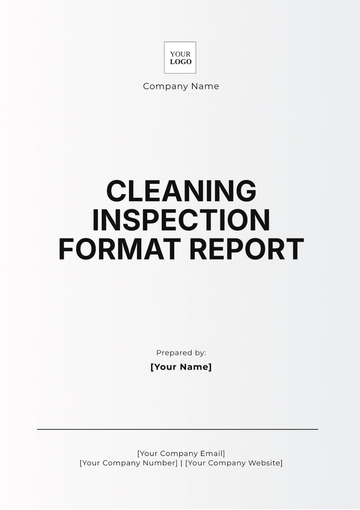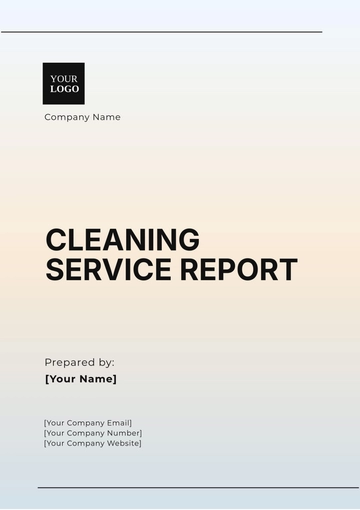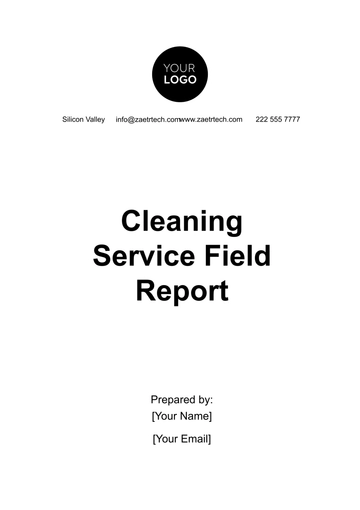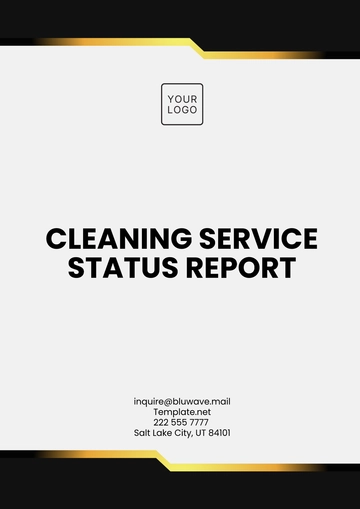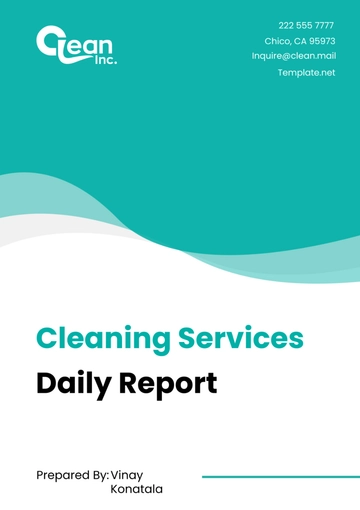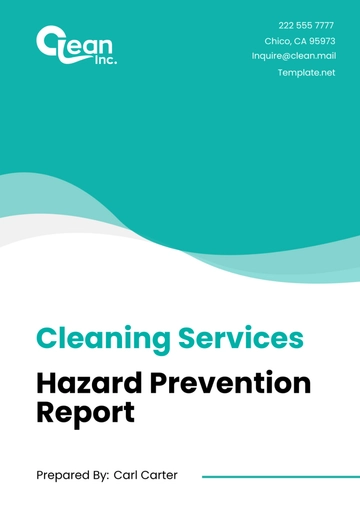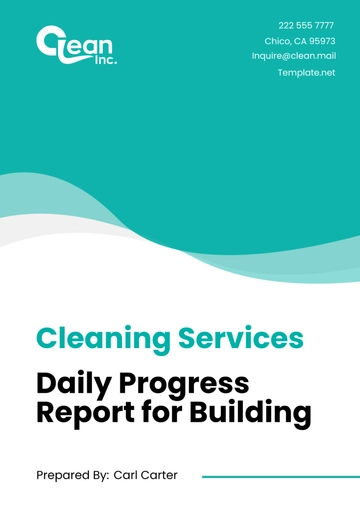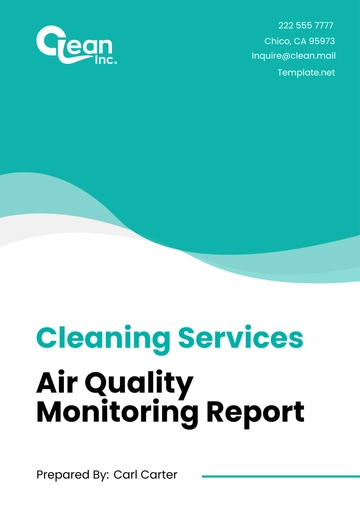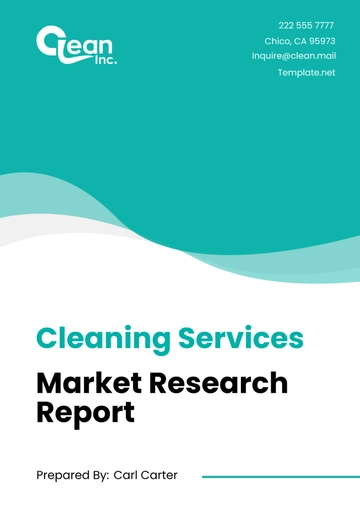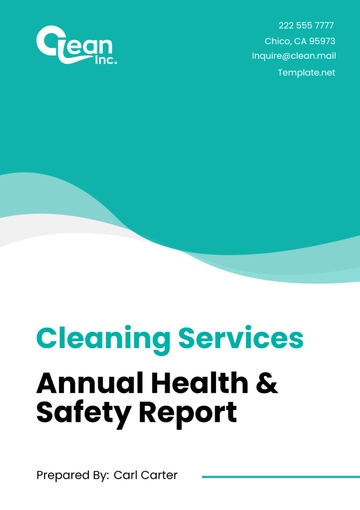Free Cleaning Services Market Research Report

I. Introduction
A. Background
The cleaning services industry plays a vital role in maintaining hygiene and safety across residential, commercial, and industrial spaces. As urbanization accelerates, the demand for professional cleaning services continues to rise. [Your Company Name], being an established player in this sector, recognizes the significance of contributing to cleanliness, health, and well-being.
Our research endeavors to address these:
Emerging Trends in Cleaning Services:
1.1. We delve into the latest developments, including automation, green cleaning practices, and the adoption of smart technologies.
1.2. How can [Your Company Name] stay at the forefront of these trends and adapt its services accordingly?
Market Positioning
2.1. [Your Company Name] already has a foothold in the market. However, how can we strengthen our position further?
2.2. What strategies can we employ to differentiate ourselves from competitors?
B. Purpose
Our research serves several purposes:
Market Assessment
1.1. Evaluate the size, growth rate, and potential of the cleaning services market.
1.2. Identify gaps and opportunities for [Your Company Name] to expand its services.
1.3. Understand regional variations and niche markets.
Competitive Analysis
2.1. Analyze competitors’ strengths, weaknesses, and market positioning.
2.2. Benchmark [Your Company Name]'s offerings against industry leaders.
2.3. Explore innovative ways to outperform competitors.
Strategic Decision-Making
3.1. Provide insights for [Your Company Name]'s leadership team to make informed decisions.
3.2. Align business strategies with market dynamics.
3.3. Identify areas for investment and resource allocation.
C. Scope
Our research encompasses:
Global and regional analysis of the cleaning services market.
Various service types, including janitorial, carpet cleaning, specialized cleaning for healthcare facilities, and more.
Customer segments (residential, commercial, industrial) and their unique requirements.
D. Objectives
The objectives are the following:
Assess market size, growth rates, and competitive landscape.
Understand consumer behavior and preferences.
Evaluate regulatory implications and compliance requirements.
II. Market Overview
The global cleaning services industry continues to thrive, driven by technological advancements, sustainability initiatives, and evolving consumer demands. Let’s delve into the data for the period from 2055 to 2057:
Market Metrics | 2055 | 2056 | 2057 |
|---|---|---|---|
Total Market Size | $129,800,000,000 | $138,200,000,000 | $146,900,000,000 |
Annual Growth Rate (CAGR) | 6.4% | 6.2% | 6.0% |
Insights:
Total Market Size
In 2055, the global cleaning services market reached approximately USD 129.80 billion.
Over the next two years, the market is projected to grow steadily, reaching USD 138.20 billion in 2056 and USD 146.90 billion in 2057.
[Your Company Name] operates within this substantial market, providing essential cleaning solutions across various sectors.
Annual Growth Rate (CAGR)
The compound annual growth rate (CAGR) remains consistent at around 6.0%–6.4% during this period.
This sustained growth signifies increasing demand for cleaning services worldwide.
[Your Company Name] should strategically position itself to capitalize on this upward trend.
III. Industry Trends
The cleaning services market is evolving rapidly, driven by technological advancements, shifting consumer preferences, and sustainability concerns. In this section, we delve into key trends that are shaping the industry landscape. The following table provides a concise overview of these trends:
Industry Trends | Impact |
|---|---|
Sustainable Practices | Accelerating shift towards green cleaning services, reducing plastic wastage, and promoting recycling rates. |
Robotic Technology Adoption | Increasing efficiency and precision in cleaning processes. |
Healthcare Sector Demand | Growing need to meet hygiene standards in healthcare settings. |
Outsourcing vs. In-House Services | Rising preference for outsourcing cleaning services. |
Technological Innovations | Interoperability and new cleaning equipment driving market growth. |
Insights:
Sustainable Practices
The industry is embracing sustainability. Green cleaning services are gaining traction, with a focus on reducing plastic waste and enhancing recycling rates.
Companies that prioritize eco-friendly practices align with consumer expectations and contribute to a healthier environment.
Robotic Technology Adoption
Robotic cleaners are revolutionizing the industry. Their adoption improves process efficiency, reduces labor costs, and ensures consistent results.
Cleaning companies investing in robotic solutions gain a competitive edge and enhance service quality.
Healthcare Sector Demand
Hygiene standards in healthcare facilities drive demand for cleaning services. Hospitals, clinics, and medical centers require specialized cleaning to maintain patient safety.
Companies catering to the healthcare sector benefit from steady contracts and long-term partnerships.
Outsourcing vs. In-House Services
Businesses increasingly prefer outsourcing cleaning services. Outsourced providers offer expertise, flexibility, and cost-effectiveness.
In-house services may struggle to match the efficiency and specialized offerings of professional cleaning companies.
Staying abreast of trends allows [Your Company Name] to adapt proactively. Strategic planning ensures agility in a dynamic market. Understanding trends also helps [Your Company Name] differentiate its offerings. Whether through sustainable practices or technological innovations, unique selling points attract clients.
Adapting to industry trends ensures resilience. Companies that evolve with the market remain competitive and relevant. [Your Company Name] needs to align its strategies with prevailing trends to thrive in the cleaning services sector.
IV. Competitive Landscape
The competitive landscape in the cleaning services market is dynamic, with several players vying for market share. In this section, we present a comparative analysis of key competitors, highlighting their strengths and strategic positioning. The following table provides insights into the major players:
Competitor | Market Share | Key Strengths |
|---|---|---|
[Competitor Name] | 18.5% |
|
[Your Company Name] | 20.0% |
|
Other Competitors | 61.5% |
|
Insights:
[Competitor Name]:
With an impressive market share of 18.5%, [Competitor Name] stands out.
Strengths:
Brand Reputation: [Competitor Name] has built a strong brand over the years, instilling trust among clients.
Service Portfolio: Their comprehensive range of services, including window cleaning, floor care, and specialized cleaning, caters to diverse needs.
Client Relationships: [Competitor Name] maintains long-term relationships with clients, ensuring repeat business.
Technological Innovation: Their adoption of robotic cleaning technology enhances efficiency.
Sustainability: [Competitor Name] prioritizes eco-friendly practices, appealing to environmentally conscious clients.
[Your Company Name]:
[Your Company Name] has secured a significant market share of 20.0%, positioning itself as a major player.
Strengths:
Tailored Solutions: [Your Company Name] offers customized cleaning solutions based on client requirements.
Customer Satisfaction: High levels of customer satisfaction contribute to repeat business and positive word-of-mouth.
Strategic Partnerships: Collaborating with property management companies ensures a steady stream of contracts.
Green Practices: [Your Company Name] emphasizes eco-friendly cleaning, aligning with sustainability trends.
Other Competitors
These players collectively hold 61.5% of the market share.
Strengths:
Diverse Offerings: Other competitors provide a wide array of services, from janitorial to carpet cleaning.
Regional Expertise: They understand local nuances and adapt services accordingly.
Pricing: Competitive pricing strategies attract cost-conscious clients.
Niche Focus: Some competitors specialize in specific sectors, such as healthcare or educational facilities.
Understanding competitors’ strengths helps [Your Company Name] identify gaps and opportunities. Analyzing their service portfolios guides [Your Company Name]'s expansion plans.
[Your Company Name] can also learn from competitors’ successful practices and innovate further. Strategic alliances with other players can lead to synergies and market dominance. [Your Company Name] should explore collaboration opportunities.
V. Consumer Behavior and Preferences
Understanding consumer behavior and preferences is crucial for [Your Company Name] to tailor its cleaning services effectively. The following table provides a snapshot of consumer metrics:
Consumer Metrics | 2055 | 2056 | 2057 |
|---|---|---|---|
Customer Satisfaction | 85% | 87% | 88% |
Preference for Eco-Friendly | 72% | 75% | 78% |
Technology Adoption | 60% | 62% | 65% |
Service Customization | 68% | 70% | 72% |
Insights:
Customer Satisfaction
Consumer satisfaction remains consistently high, with 85% in 2055, rising to 88% by 2057.
[Your Company Name] should continue prioritizing service quality and responsiveness to maintain this positive trend.
Preference for Eco-Friendly Services
Consumers increasingly value sustainability. The percentage of eco-conscious customers rises from 72% in 2055 to 78% in 2057.
[Your Company Name] can leverage its green cleaning practices to attract and retain environmentally aware clients.
Technology Adoption
Consumers are open to technological innovations. The adoption rate grows from 60% in 2055 to 65% in 2057.
[Your Company Name] should explore smart cleaning solutions and robotic technology to enhance efficiency.
Service Customization
Clients appreciate personalized services. The demand for customized cleaning solutions increases steadily.
[Your Company Name] can tailor offerings based on specific client needs, ensuring higher satisfaction.
Satisfied customers are more likely to remain loyal. [Your Company Name] should focus on exceeding expectations. Personalized services can help us enhance customer retention.
Understanding consumer preferences also allows [Your Company Name] to differentiate itself. It is important to note that Eco-friendly practices and technological adoption set [Your Company Name] apart from competitors.
Moreover, happy clients become brand advocates. Positive reviews and referrals drive new business. [Your Company Name] should actively seek feedback and testimonials.
In general, the insights about consumers guide our company, [Your Company Name], and play a crucial role in the long-term planning of our strategic decisions. By understanding and anticipating the trends, we ensure that our company remains adaptable to changing market conditions, thereby leading to sustained growth in our marketplace.
VI. Regulatory Environment
The cleaning services industry operates within a complex regulatory framework that significantly impacts business practices, safety standards, and environmental considerations. Here are key aspects of the regulatory environment:
A. Health and Safety Regulations
Occupational Safety and Health Administration (OSHA): OSHA, a federal agency, sets stringent guidelines for workplace safety, including cleaning service providers. Compliance with OSHA standards ensures employee well-being, minimizes workplace accidents, and fosters a safe working environment.
Chemical Handling and Disposal: Regulations govern the use, storage, and disposal of cleaning chemicals. Proper labeling, training, and protective gear are essential to prevent harm to workers and the environment.
Pandemic Preparedness: Events like the COVID-19 pandemic underscore the need for preparedness. Cleaning companies must adhere to guidelines for infection control, sanitation, and protective measures to safeguard both employees and clients.
B. Environmental Regulations
Eco-Friendly Practices: Governments worldwide advocate for green cleaning solutions. Compliance with regulations promoting biodegradable ingredients, sustainable practices, and reduced environmental impact is essential. Companies that prioritize eco-friendly cleaning contribute to public health and environmental well-being.
Waste Management: Proper disposal of cleaning waste is crucial. Compliance with waste management regulations prevents pollution, health hazards, and negative ecological effects. Recycling and responsible waste handling are integral to sustainable business practices.
Sustainable Packaging: Regulations encourage the use of eco-friendly packaging materials. It is crucial to explore sustainable alternatives to reduce plastic waste and promote environmental stewardship. Packaging choices impact not only the environment but also consumer perception and brand reputation.
VII. Market Opportunities and Challenges
The cleaning services market presents a dynamic landscape with both promising opportunities and significant challenges. As [Your Company Name] navigates this industry, understanding these factors is crucial for strategic planning:
A. Opportunities
Green Cleaning Services
1.1. Opportunity: There is a growing demand for eco-friendly cleaning solutions as consumers become more environmentally conscious.
1.2. Importance: By offering green cleaning options, [Your Company Name] can capitalize on sustainability trends and attract environmentally aware clients.
1.3. Action: Develop and promote environmentally conscious cleaning products and practices that align with consumer preferences.
Technological Innovations
2.1. Opportunity: The adoption of smart devices, robotics, and AI is transforming the industry.
2.2. Importance: Investing in technology enhances efficiency, quality, and overall service delivery.
2.3. Action: Explore smart cleaning solutions and consider integrating robotic technology into your service offerings.
Healthcare Sector Expansion
3.1. Opportunity: The increasing need for cleaning services in healthcare facilities presents growth potential.
3.2. Importance: Specialized cleaning for hospitals, clinics, and nursing homes is essential to meet stringent hygiene standards.
3.3. Action: Tailor your services to cater to the unique requirements of healthcare settings.
B. Challenges
High Turnover Rate
1.1. Challenge: The cleaning industry faces excessive turnover and low morale among employees.
1.2. Importance: Recruitment and retention of well-trained staff remain challenging due to the demanding nature of the work.
1.3. Action: Prioritize employee satisfaction, invest in training programs, and create a positive work environment.
Fierce Competition
2.1. Challenge: The market is saturated, leading to intense competition among cleaning service providers.
2.2. Importance: [Your Company Name] must differentiate itself to stand out and attract clients.
2.3. Action: Develop unique selling propositions, focus on service quality, and build strong client relationships.
Increasing Costs
3.1. Challenge: Balancing quality and cost-effectiveness is a constant struggle.
3.2. Importance: Investment in technology, compliance with regulations, and employee benefits require financial resources.
3.3. Action: Optimize operational costs while maintaining service excellence and client satisfaction.
Adapting to Industry Trends
4.1. Challenge: The industry evolves rapidly due to technological advancements and changing consumer preferences.
4.2. Importance: Staying abreast of trends ensures adaptability and relevance in a competitive market.
4.3. Action: Continuously monitor market shifts, adjust strategies, and embrace innovation.
Quality Control and Consistency
5.1. Challenge: Maintaining consistent service quality across different clients and locations is a persistent challenge.
5.2. Importance: Reputation and client satisfaction depend on reliable and uniform cleaning standards.
5.3. Action: Implement robust quality control processes, regular training for cleaning staff, and performance monitoring.
VIII. Conclusion
In this market research report, we have explored the intricacies of an industry that plays a vital role in maintaining hygiene, safety, and well-being across various sectors. As [Your Company Name], you are positioned to thrive in this dynamic landscape by leveraging opportunities, addressing challenges, and embracing innovation.
The cleaning services market is not just about tidying up spaces; it’s about creating healthier environments, leaving positive impressions, and ensuring safety. As [Your Company Name], your commitment to excellence and adaptability will drive your success.
By always staying aware and alert to all of the changing trends within the cleaning industry, keeping up-to-date with relevant regulations, and continuously learning about and adapting to the ever-changing preferences of the consumers, [Your Company Name] is well-positioned for success. This level of active awareness and adaptability can help you to make a long-lasting and significant impact in this crucial field of work.
- 100% Customizable, free editor
- Access 1 Million+ Templates, photo’s & graphics
- Download or share as a template
- Click and replace photos, graphics, text, backgrounds
- Resize, crop, AI write & more
- Access advanced editor
Generating a presentable and precise report while saving time is achievable with our editable Cleaning Services Market Research Report Template! This customizable report only on Template.net, allows you to conduct a detailed market research report. With our user-friendly AI Editor Tool you can make informed decisions about your cleaning services!
You may also like
- Sales Report
- Daily Report
- Project Report
- Business Report
- Weekly Report
- Incident Report
- Annual Report
- Report Layout
- Report Design
- Progress Report
- Marketing Report
- Company Report
- Monthly Report
- Audit Report
- Status Report
- School Report
- Reports Hr
- Management Report
- Project Status Report
- Handover Report
- Health And Safety Report
- Restaurant Report
- Construction Report
- Research Report
- Evaluation Report
- Investigation Report
- Employee Report
- Advertising Report
- Weekly Status Report
- Project Management Report
- Finance Report
- Service Report
- Technical Report
- Meeting Report
- Quarterly Report
- Inspection Report
- Medical Report
- Test Report
- Summary Report
- Inventory Report
- Valuation Report
- Operations Report
- Payroll Report
- Training Report
- Job Report
- Case Report
- Performance Report
- Board Report
- Internal Audit Report
- Student Report
- Monthly Management Report
- Small Business Report
- Accident Report
- Call Center Report
- Activity Report
- IT and Software Report
- Internship Report
- Visit Report
- Product Report
- Book Report
- Property Report
- Recruitment Report
- University Report
- Event Report
- SEO Report
- Conference Report
- Narrative Report
- Nursing Home Report
- Preschool Report
- Call Report
- Customer Report
- Employee Incident Report
- Accomplishment Report
- Social Media Report
- Work From Home Report
- Security Report
- Damage Report
- Quality Report
- Internal Report
- Nurse Report
- Real Estate Report
- Hotel Report
- Equipment Report
- Credit Report
- Field Report
- Non Profit Report
- Maintenance Report
- News Report
- Survey Report
- Executive Report
- Law Firm Report
- Advertising Agency Report
- Interior Design Report
- Travel Agency Report
- Stock Report
- Salon Report
- Bug Report
- Workplace Report
- Action Report
- Investor Report
- Cleaning Services Report
- Consulting Report
- Freelancer Report
- Site Visit Report
- Trip Report
- Classroom Observation Report
- Vehicle Report
- Final Report
- Software Report
